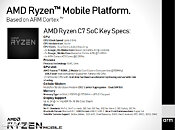Monday, June 1st 2020

AMD "Ryzen C7" Smartphone SoC Specifications Listed
Last year Samsung and AMD announced their collaboration which promises to deliver smartphone chips with AMD RDNA 2 graphics at its heart. This collaboration is set to deliver first products sometime at the beginning of 2021 when Samsung will likely utilize new SoCs in their smartphones. In previous leaks, we have found that the GPU inside this processor is reportedly beating the competition form Qualcomm, where the AMD GPU was compared to Adreno 650. However, today we have obtained more information about the new SoC which is reportedly called "Ryzen C7" smartphone SoC. A new submission to a mobile phone leaks website called Slash Leaks has revealed a lot of new details to us.
The SoC looks like a beast. Manufactured on TSMC 5 nm process, it features two Gaugin Pro cores based on recently announced Arm Cortex-X1, two Gaugin cores based on Arm Cortex-A78, and four cores based on Arm Cortex-A55. This configuration represents a standard big.LITTLE CPU typical for smartphones. Two of the Cortex-X1 cores run at 3 GHz, two of Cortex-A78 run at 2.6 GHz, while four little cores are clocked at 2 GHz frequency. The GPU inside this piece of silicon is what is amazing. It features four cores of custom RDNA 2 based designs that are clocked at 700 MHz. These are reported to beat the Adreno 650 by 45% in performance measurements.
Source:
@HansDeVriesNL (Twitter)
The SoC looks like a beast. Manufactured on TSMC 5 nm process, it features two Gaugin Pro cores based on recently announced Arm Cortex-X1, two Gaugin cores based on Arm Cortex-A78, and four cores based on Arm Cortex-A55. This configuration represents a standard big.LITTLE CPU typical for smartphones. Two of the Cortex-X1 cores run at 3 GHz, two of Cortex-A78 run at 2.6 GHz, while four little cores are clocked at 2 GHz frequency. The GPU inside this piece of silicon is what is amazing. It features four cores of custom RDNA 2 based designs that are clocked at 700 MHz. These are reported to beat the Adreno 650 by 45% in performance measurements.

50 Comments on AMD "Ryzen C7" Smartphone SoC Specifications Listed
Still wouldn't mind one ,those X1 core's look formidable too.
Amd arm cpu ? lol no
Samsung soc make by tsmc ? lol no
Still surprised by this :kookoo:
As for this "leak": it seems dubious to me. It purports to be an internal ARM slide, yet as noted by Ian Cuttress on Twitter, ARM hasn't officially called their cores "ARM Cortex" with ARM in all caps for quite a while. It also misspells Gauguin. Still, it would be a very, very attractive SoC, and would give Samsung a serious edge. The Ryzen branding and making it on TSMC also fits with recent rumors of AMD being an early adopter of TSMC 5nm (which is purportedly for Ryzen 4000, but if so that would postpone that launch by 4-6 months at the minimum, so that is extremely unlikely) though it doesn't align very well with Samsung's involvement here - unless they are happy to be an entirely silent partner in this, which sounds unlikely. If this is real, it'll be pretty cool, but I doubt it.
I mean, AMD has already made some custom parts for Microsoft, so why not for a different kind of product as well?
I doubt this will be for phones.
- www.amd.com/en/amd-opteron-a1100
- en.wikipedia.org/wiki/AMD_K12
AMD (as well as Intel even though they sold their ARM division to Marvell) still hold the ARM architectural licenses.This may also put the Nvidia Tegra SOC to shame with the old ARM processor and Nvidia graphics.
en.wikipedia.org/wiki/Imageon
And ATI's MIPS based SoCs.
en.wikipedia.org/wiki/XilleonThat's not what ARM said. The X1 is "off roadmap" and seemingly any ARM licensee can make their own X1 implementation, so expect a lot of different implementations to show up.
As for Exynos, well they should stick it in midrange and below along with Mediatek.
So a potential X2 might see differing implementations, but it seems that for X1, the most "custom" parts we'll see will be different cache sizes or numbers of cores.
If you consider their Flexible Access license starts at $75k and runs up to $200k for their standard package, I only imagine how much a standard license costs that allows you to get access to everything that allows you to makes changes to the underlying architecture in a meaningful way. I would guess it's a few million and that doesn't include the cost of having the right engineers that can then take advantage of the information you're given, the tape out fee to ARM and all the other costs involved in making a chip.
www.arm.com/why-arm/how-licensing-works
AMD beat intel in 99% of the scenarios, and is competing decently with Nvidia where it matters. Honestly, I don't know why AMD's stock is falling. :P
Anyways, besides the fact that it has nothing to do with...Ryzen, the GPU is nothing spectacular. By the time this launches Qualcomm will also have a new SoC, the SD875 which will bring considerable improvements given the transition to 5nm...
Also, I don't think there was something wrong with the Mali GPUs and I wouldn't be too surprised if Samsung would go from its SoC having a shitty custom CPU to a shitty custom GPU. By shitty I mean either having crap efficiency or crap drivers. Anyways, while this exotic combination of desktop gpu tech and mobile soc is nice, I don't think they can beat the efficiency of a pure mobile GPU.